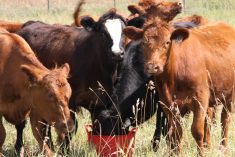RED DEER – Prices for fat steers in the United States hit a record high Feb. 24, but that feat may turn out to be short lived.
Live Texas steers sold for $111 per hundredweight and Nebraska fats fetched $112, yielding a profit of around $50 per head.
However, Duane Lenz of the U.S. market analysis firm Cattlefax said it’s unlikely those prices and profits can be sustained.
The profit was possible because the feedlots bought the cattle six months ago when prices were lower and corn was half the current price, he said in an interview during the Alberta Beef Industry conference held in Red Deer Feb. 23-25.
Read Also

Organic farmers urged to make better use of trade deals
Organic growers should be singing CUSMA’s praises, according to the Canadian Chamber of Commerce.
“Our break-evens are going to go higher every month,” he said, referring to the fed cattle price required to cover costs.
Input costs are rising, which makes profits elusive.
U.S. steer prices this year could exceed $115, well above the range of the last decade of $58 to $82 per cwt. But Lenz said forecasters are too nervous to commit beyond that because of market volatility.
While Canadian market conditions are as volatile as those in the United States, Canada has a feeding advantage because western barley is cheaper than U.S. corn, said Brian Perillat of Canfax.
He didn’t know how long that advantage might remain.
“Day to day, you could wake up one morning and your cattle could be up $30 or $30 down.”
Cow-calf producers have the most to gain from higher calf prices. Feedlots face a short supply of calves and packers may find consumer resistance for higher beef prices.
Strong exports add support to beef and cattle prices.
World beef production has declined for the past five years and global demand has been healthy, even though demand is flat in North America.
U.S. beef exports are up 32 percent compared to this time last year, with considerable expansion in Asia. South Korea has been a major destination because it has had to cull millions of cattle and hogs due to of a foot-and-mouth epidemic.
The Canada Beef Export Federation reported that beef exports to Asia, Mexico and Russia increased 17 percent in 2010 compared to a four percent decrease in exports to the U.S.
Total Canadian beef exports to these markets jumped from 90,050 tonnes worth $327 million in 2009 to 105,700 tonnes valued at $426 million in 2010.
This is being achieved with smaller herds that do not appear to be prepared to expand soon.
Producers aren’t holding back enough heifers and are likely to sell calves into the beef market because of strong prices.
“We are not keeping them out and making new cows out of them,” said Lenz.
As well, southern U.S. ranchers are likely to continue downsizing due to drought that is creating shortages of water and feed.
The most recent Statistics Canada livestock survey said Canada has 4.27 million cows, down 19 percent from the large population of 2005 when BSE forced producers to retain females that could not be sold.
Heifer numbers increased three percent, but it is only a slight improvement considering how few have been retained.
Perillat said most of the extra heifers are in Western Canada.
“We’re down about 120,000 cows and we’re up about 20,000 heifers so really we will have quite a bit smaller calf crop,” he said.
“We know feedlots are going to be competing for calves.”















